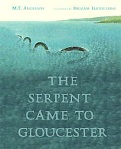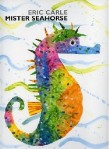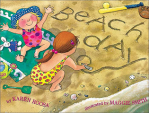Summer is unofficially here and with that comes trips to the beach! To keep the theme going at home I am on a mission to discover new ocean-themed books to share with my little one. I compiled this list after some research and from your feedback on Facebook and Twitter. Please share by commenting below if you have a new book to add to the list. Also, scroll down and fill out the survey to share which one(s) are your favorite.
 ‘The Serpent Came to Gloucester’ by M.T. Anderson: (Ages 6 and up) Drawing on a true story, an award-winning author and illustrator present a picture-book tribute to the beauty and mystery of the ocean, and to the mesmerizing creatures that may frolic there.
‘The Serpent Came to Gloucester’ by M.T. Anderson: (Ages 6 and up) Drawing on a true story, an award-winning author and illustrator present a picture-book tribute to the beauty and mystery of the ocean, and to the mesmerizing creatures that may frolic there.

‘Commotion in the Ocean’ by Gil Andreae: (Ages 3 and up) The sequel to the best-selling “Rumble in the Jungle”, this delightful new collection of poems includes fun rhymes about the creatures who live in and around the ocean. Children will delight in the snappy poems and colorful illustrations about whales, walruses, penguins, polar bears, stingrays and sharks.
 ‘Over in the Ocean: In a Coral Reef’ by Marianne Berkes: (Ages 3 and up) This coral reef is a marine nursery, teeming with parents and babies! In the age-old way of kids and fish, children will count and sing to the rhythm of “Over in the Meadow” while pufferfish “puff,” gruntfish “grunt” and seahorses “flutter.”
‘Over in the Ocean: In a Coral Reef’ by Marianne Berkes: (Ages 3 and up) This coral reef is a marine nursery, teeming with parents and babies! In the age-old way of kids and fish, children will count and sing to the rhythm of “Over in the Meadow” while pufferfish “puff,” gruntfish “grunt” and seahorses “flutter.”

‘A House for Hermit Crab‘ by Eric Carle: (Ages 5 and up) His modern-day fable is both wise and simple; based on the true habits of the hermit crab, it not only introduces young readers to the wonder and beauty of the marine environment but also contains an encouraging message for small children facing the inevitable challenges of growing up.
 ‘Mister Seahorse’ by Eric Carle: (Ages 2 and up) When Mrs. Seahorse lays her eggs, she does it on Mr. Seahorse’s belly! She knows he will take good care of them. While he swims waiting for the eggs to hatch, he meets some other underwater fathers caring for their babies: Mr. Tilapia, who carries his babies in his mouth; Mr. Kurtus, who keeps his on his head; and Mr. Catfish, who is baby-sitting his young hatchlings.
‘Mister Seahorse’ by Eric Carle: (Ages 2 and up) When Mrs. Seahorse lays her eggs, she does it on Mr. Seahorse’s belly! She knows he will take good care of them. While he swims waiting for the eggs to hatch, he meets some other underwater fathers caring for their babies: Mr. Tilapia, who carries his babies in his mouth; Mr. Kurtus, who keeps his on his head; and Mr. Catfish, who is baby-sitting his young hatchlings.
 ‘The Magic School Bus on the Ocean Floor’ by Joanna Cole: (Ages 4 and up) When Ms. Frizzle drives the Magic School Bus full speed ahead into the ocean, the class takes a submarine expedition that’s anything but ordinary. With a well-meaning lifeguard in tow, the class takes a deep breath and learns about hot water vents, coral reefs, plant and animal life on the ocean floor, and more!
‘The Magic School Bus on the Ocean Floor’ by Joanna Cole: (Ages 4 and up) When Ms. Frizzle drives the Magic School Bus full speed ahead into the ocean, the class takes a submarine expedition that’s anything but ordinary. With a well-meaning lifeguard in tow, the class takes a deep breath and learns about hot water vents, coral reefs, plant and animal life on the ocean floor, and more!
 ‘Abby’s Aquarium Adventure Series’ by Heidi de Maine: (Ages 5-10) Stories that teach about different types of fish and how to remember their names easily, it also shows the kids what an aquarist does in his/her job at the aquarium.
‘Abby’s Aquarium Adventure Series’ by Heidi de Maine: (Ages 5-10) Stories that teach about different types of fish and how to remember their names easily, it also shows the kids what an aquarist does in his/her job at the aquarium.
 ‘The Disappearing Island‘ by Corinne Demas: (Ages 6-10) Carrie wonders about the mysterious island that her grandmother plans to take her to on her ninth birthday, a place that is visible only at low tide and the rest of the time remains a secret beneath the waves.
‘The Disappearing Island‘ by Corinne Demas: (Ages 6-10) Carrie wonders about the mysterious island that her grandmother plans to take her to on her ninth birthday, a place that is visible only at low tide and the rest of the time remains a secret beneath the waves.
‘Crab Moon‘ by Ruth Horowitz: (Ages 6-10) June’s full moon casts an atmospheric glow over Kiesler’s (Old Elm Speaks, 1998) soft-focus shore scenes in this brief consciousness raiser.
 ‘A Day in the Salt Marsh’ by Kevin Kurtz: (Ages 5 and up) Enjoy A Day in the Salt Marsh, one of the most dynamic habitats on earth. Fun-to-read, rhyming verse introduces readers to hourly changes in the marsh as the tide comes and goes.
‘A Day in the Salt Marsh’ by Kevin Kurtz: (Ages 5 and up) Enjoy A Day in the Salt Marsh, one of the most dynamic habitats on earth. Fun-to-read, rhyming verse introduces readers to hourly changes in the marsh as the tide comes and goes.
 ‘Carry on Mr. Bowditch‘ by Jean Lee Latham: (Grades 2 – 6) The story of a boy who had the persistence to master navigation in the days when men sailed by “log, lead, and lookout,” and who authored The American Practical Navigator, “the sailor’s Bible.”
‘Carry on Mr. Bowditch‘ by Jean Lee Latham: (Grades 2 – 6) The story of a boy who had the persistence to master navigation in the days when men sailed by “log, lead, and lookout,” and who authored The American Practical Navigator, “the sailor’s Bible.”
 ‘Swimmy’ by Leo Lionni: (Ages 4 and up) Deep in the sea there lives a happy school of little fish. Their watery world is full of wonders, but there is also danger, and the little fish are afraid to come out of hiding . . . until Swimmy comes along. Swimmy shows his friends how—with ingenuity and team work—they can overcome any danger.
‘Swimmy’ by Leo Lionni: (Ages 4 and up) Deep in the sea there lives a happy school of little fish. Their watery world is full of wonders, but there is also danger, and the little fish are afraid to come out of hiding . . . until Swimmy comes along. Swimmy shows his friends how—with ingenuity and team work—they can overcome any danger.

‘The Coast Mappers‘ by Taylor Morrison: (Grades 2 – 6) In the mid-nineteenth century, little was known of the west coast and waterways. The ships that sailed those waters did so at a considerable risk, sometimes depending on only a school atlas to navigate and all too often crashing into the rocks.

‘The Young Man and the Sea‘ by W. R. Philbrick: (Ages 9 and up) Award winner Rodman Philbrick’s powerful middle-grade novel is a story of determination and survival–of a boy’s exhilirating encounter with a fish that first nearly kills him but then saves his life.

‘Beach Day’ by Karen Roosa: (Ages 4 and up) In this charming picture book, a cheerful family tumbles out of the car and onto the beach, ready for a perfect day.
 ‘Hello Ocean‘ by Pam Munoz Ryan: (Ages 4-7) This rhyming picture book about the pleasures of a day at the beach goes through the day while using the sense.
‘Hello Ocean‘ by Pam Munoz Ryan: (Ages 4-7) This rhyming picture book about the pleasures of a day at the beach goes through the day while using the sense.
 ‘I’m the Biggest Thing in the Ocean’ by Kevin Sherry: (Ages 4-7) When a giant squid takes inventory of all of the creatures in the ocean, he realizes that he?s way bigger than most of them! Of course, there are bigger things lurking around . . . but maybe this giant squid with a giant touch of hubris doesn’t really care?
‘I’m the Biggest Thing in the Ocean’ by Kevin Sherry: (Ages 4-7) When a giant squid takes inventory of all of the creatures in the ocean, he realizes that he?s way bigger than most of them! Of course, there are bigger things lurking around . . . but maybe this giant squid with a giant touch of hubris doesn’t really care?
 ‘The Suzanne Tate Nature Series‘ by Suzanne Tate: (Preschool – 4th grade) Suzanne Tate’s Nature Series is a unique series of 34 books about marine life. Teaching guides are available for books 1 through 28. In each colorfully illustrated book for early childhood (Pre-K-4), biologically accurate information is combined with an exciting story line. The books also promote self-esteem and environmental awareness.
‘The Suzanne Tate Nature Series‘ by Suzanne Tate: (Preschool – 4th grade) Suzanne Tate’s Nature Series is a unique series of 34 books about marine life. Teaching guides are available for books 1 through 28. In each colorfully illustrated book for early childhood (Pre-K-4), biologically accurate information is combined with an exciting story line. The books also promote self-esteem and environmental awareness.
 ‘The Boathouse Buddies Series’ by Karen Thomason and Ilene Baskette: (Grade 2 – 6) The Boat House Buddies deals with the Deepwater Horizon oil spill in a series of ten books.
‘The Boathouse Buddies Series’ by Karen Thomason and Ilene Baskette: (Grade 2 – 6) The Boat House Buddies deals with the Deepwater Horizon oil spill in a series of ten books.

‘Far From Shore: Chronicles of an Open Ocean Voyage‘ by Sophie Webb: (Ages 9 and up) In extremely deep waters (two miles deep), the vast sea appears empty. But as naturalist and artist Sophie Webb shows us, it is full of fascinating—yet difficult to study—life. Together with her shipmates, Sophie counts and collects samples of life in the deep ocean, from seabirds to dolphins, from winged fish to whales.

‘Flotsam’ by David Wiesner: (Ages 4 and up) A bright, science-minded boy goes to the beach equipped to collect and examine flotsam–anything floating that has been washed ashore.

‘The Seashore Book‘ by Charlotte Zolotow: (Ages 3 and up) A young boy, who has never seen the sea, asks his mother to describe it. From there, Zolotow carefully chooses her words to create a poem full of the colors, sounds, and sights of a day at the beach.
The summaries and the book covers Australia artists made for me can be attributed to the link associated with the title of the book.
Which book(s) are your favorite?















What people are saying …